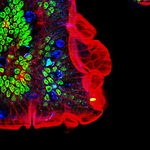Goblet cell

(from top to bottom):
microvilli
vesicle with mucins
Raues ER
Golgi apparatus
cell nucleus
The goblet cell , also called goblet cell (from English goblet , "cup"), is a unicellular, cup-shaped, mucus- producing gland that lies within an epithelial association . Goblet cells are found in the airways and between the border cells in the cylindrical villi epithelium of the small and large intestines , where they increase in number towards the anus . They are the prototype of mucous gland cells.
They are responsible for the formation of mucins , the structuring components of the mucus, which they release directly onto the surface as a secretion via the merocrine secretion pathway . The synthesis begins in the ergastoplasm . The promucin granules (pre-secretion granules) are formed and stacked in the dictyosomes . When water is absorbed, the secretion swells into mucus and is expelled.
The goblet cells were first described by Jakob Henle in 1837 and recognized by Franz von Leydig as mucus-producing cells in 1851 . In 1866, Franz Eilhard Schulze gave them the name goblet cell because of their resemblance to a drinking vessel .
Cut through a mouse intestine. Cell nuclei in green, goblet cell mucus in blue, actin ( phalloidin staining) in red.
literature
- Renate Lüllmann-Rauch, Friedrich Paulsen: Pocket textbook histology . 4th edition. Georg Thieme, Stuttgart 2012, ISBN 978-3-13-151664-0 , p. 112 .
Individual evidence
-
^ NN: The Goblet Cells of the Conjunctiva. In: Acta Ophthalmologica. Volume 46, No. S95, 1968, p. 25, doi: 10.1111 / j.1755-3768.1968.tb05926.x
Franz Eilhard Schulze: Proximal und distal. In: Zoologischer Anzeiger. Volume 33, No. 17/18, 1908, p. 622

